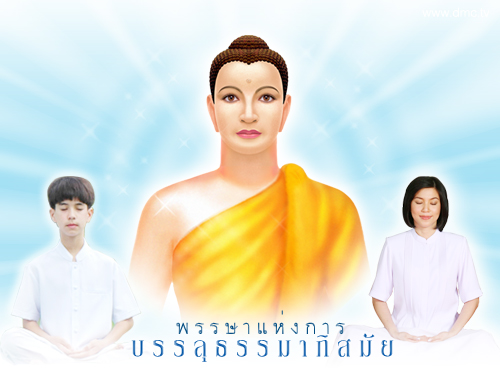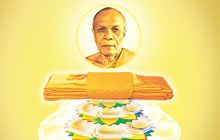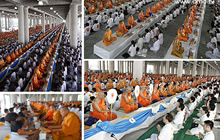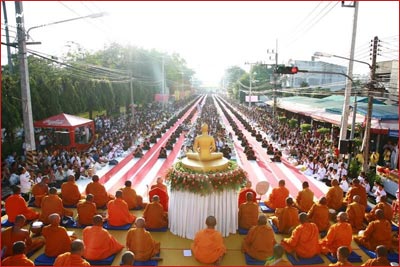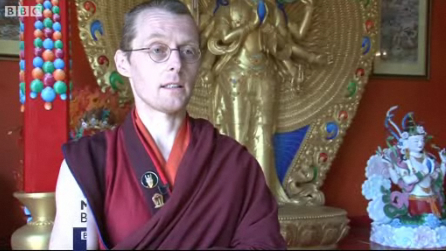
A four-meter-tall statue of the Buddha adorned with flowers and Indonesian and Buddhist flags. (Photo: Sylviana Hamdani, JG)
Jakarta Temple Honors the Old Ways of Buddhist Monks
According
to one legend, about 2,500 years ago, during Vassa, the monsoon season
in Nepal, 30 monks journeyed along roadsides and rain-soaked rice
fields to spend the season with Siddharta Gautama — later known as the
Buddha.
Due to the treacherously wet conditions, they were
forced to shelter at a monastery, where they spent their time studying,
praying and meditating until the weather cleared and it was time for
them to move on.
The rainy season retreat became a tradition for monks that has persevered until today.
The
Kathina festival celebrating the end of Vassa is held at different
monasteries in Jakarta on different days between mid-October and
mid-November.
“For Buddhists, Kathina is the second-largest
celebration after Vesak [the birthday of Buddha Siddharta Gautama],”
said Ruby Santamoko, a representative of the Indonesian Buddhist
Council (Walubi).
At Buddha Metta Arama, the oldest Theravada
(the ancient teaching) Buddhist monastery in the capital, Kathina was
celebrated on Sunday.
“That morning over 1,300 people gathered
at the monastery,” said Paba Karo, a monk who has lived at Buddha Metta
Arama for 10 years.
The celebration began at 9 a.m. with
prayers. Then, one by one, children dressed in colorful traditional
clothes stepped forward to make offering of fruits, flowers, candles
and incense sticks.
Forty-seven senior monks from Indonesia, Nepal, India, South Korea and Thailand presided over the event.
“I’m very surprised to see the number of people who attended today’s celebration,” said Prat Suprim, a monk from Nepal.
At
noon, the Thai Embassy held a ceremony at the monastery, attended by
representatives of Asian embassies, including Nepal, Laos, Vietnam,
South Korea and Singapore.
“Today’s ceremony is a tradition
for Buddhists after the rainy season. The monks stay in the temples
during the rainy season, because we, as Buddhists, do not want to step
on the living things that come out during that time,” said Thailand’s
ambassador to Indonesia, Akrasid Amatayakul.
A four-meter-tall
statue of the Buddha, flanked by statues of two of his faithful
students, Ananda and Mogalana, and adorned with flowers and Indonesian
and Buddhist flags, was the centerpiece of the ceremony. Incense filled
the air as 47 monks recited prayers in the ancient Pali language.
“They
pray the gifts will bring blessings — both for the monks who will use
them and for the congregation that offered them,” said monk Karo.
Piyawat
Niyomrerks, deputy permanent secretary to the Ministry of Foreign
Affairs of Thailand, acting as a representative of King Bhumibol
Adulyadej of Thailand, offered the gift of royal robes to the monks
sitting in the front row.
“In Thailand, Kathina is one of the
main religious events in the Buddhist calendar,” Piyawat said. “Thai
Theravada Buddhists traditionally offer monks robes after the Buddhist
Lent. As a devout Buddhist, His Majesty King Bhumibol Adulyadej adheres
to this tradition and annually bestows the Royal Kathina Robe upon
several Buddhist temples within Thailand and in other countries where
Buddhist communities and temples exist, including Indonesia.”
After
the prayers, guests gave the monks gifts of basic necessities, such as
towels, cakes of soap, tea, coffee and cookies. Some of the
congregation also offered money in small red envelopes to the monks.
“The
funds collected from today’s ceremony will be used to build temples in
remote areas throughout the country,” Paba Karo said.
“We
believe that the alms given during the Kathina month will bring special
blessings,” said Fanny Chua, who attended the ceremony.

